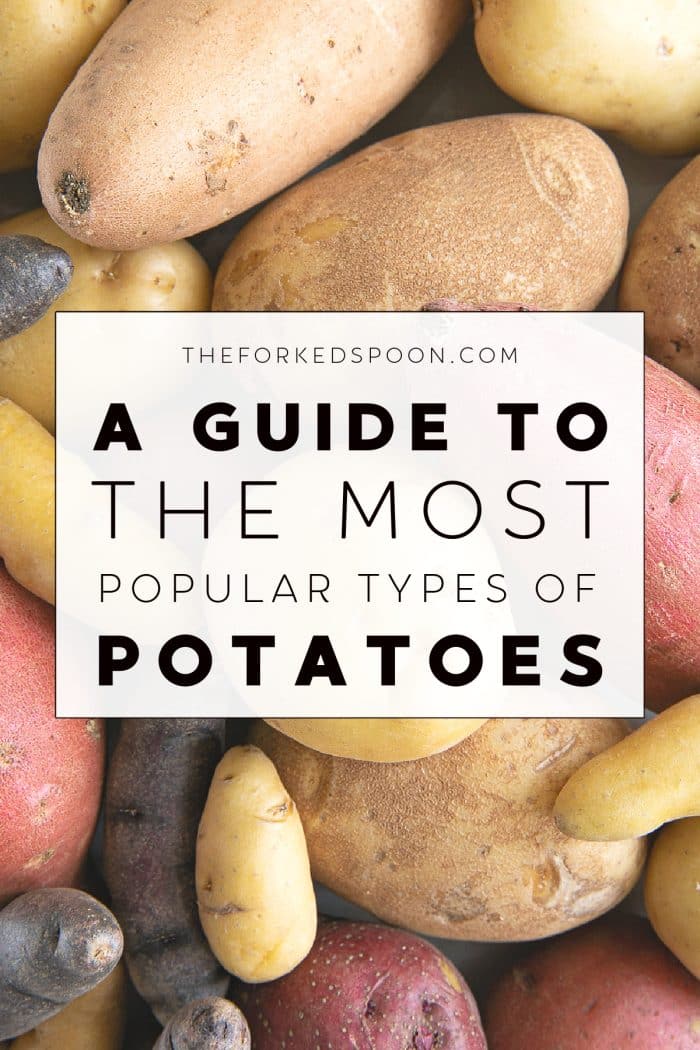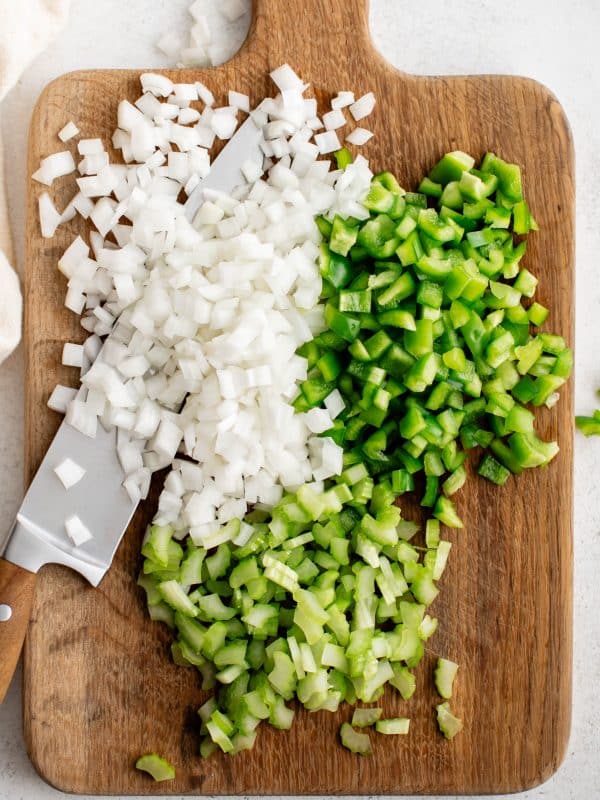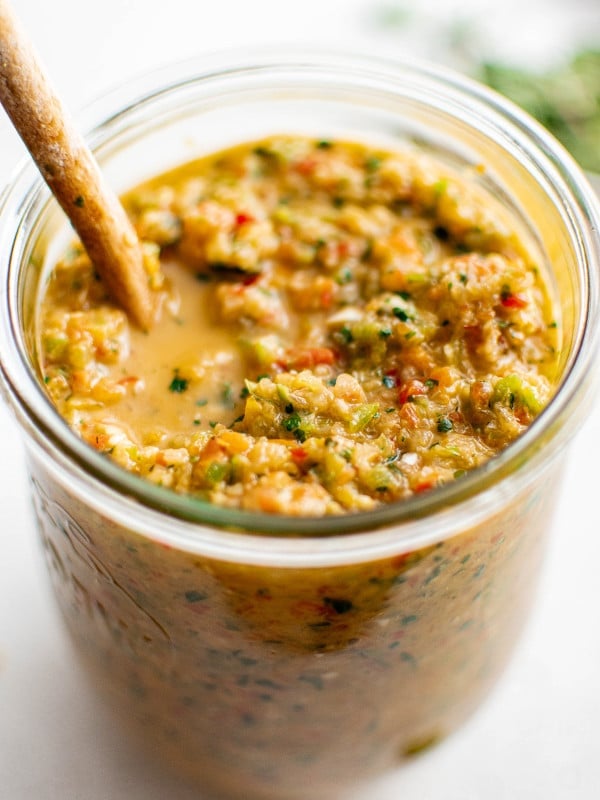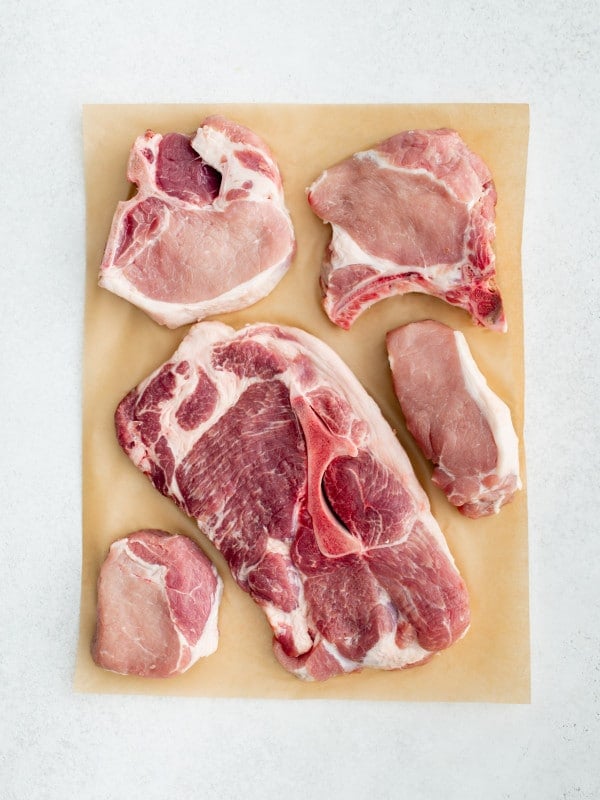This post may contain affiliate links. See my disclosure policy.
A guide to the most popular types of potatoes. Potatoes are one of the most beloved foods to ever sprout from the earth, with nearly every culture having its own preferred variety and preparation.
Let’s take a brief look at the history of this famous root vegetable, examine its various uses, and share some easy and delicious potato recipes so that you can start cooking this versatile spud at home!
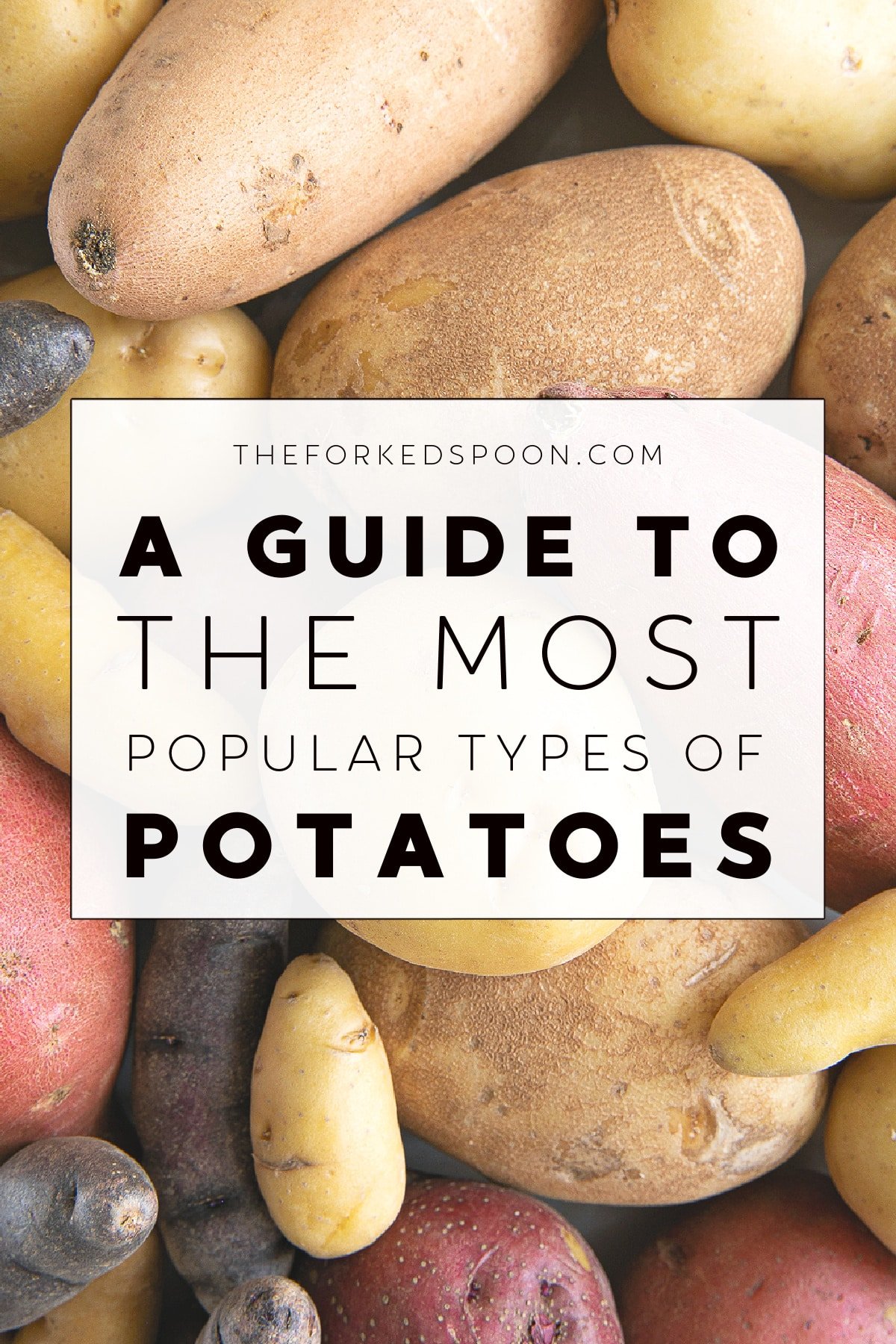
Table of Contents
Potato Basics
The potato is the starchy tuber of the Solanum tuberosum plant. It belongs to the nightshade family of flowering plants, Solanaceae, and is both native and was first domesticated in the Andes mountains of South America.
While the vines, leaves, and flowers that sprout above the surface aren’t very remarkable, what lies beneath the surface is a nutrient-dense powerhouse of starch that feeds the world! Potatoes are the third most important food crop in the world after rice and wheat in terms of human consumption, with more than 300 million metric tons being produced each year (source).
Originating from the areas of modern-day Peru, Bolivia, and Chile, the potato was domesticated over 7,000 years ago. Since then, it has been selectively bred to consist of over 4,000 different varieties of native potatoes! That’s a whole lot of variety.
You may not be able to try them all, but it’s exciting to know that you’ll never run out of options.
What’s in a name? The English word potato comes from the Spanish word patata, which itself is a mashup of batata (sweet potato) and papa.
After all, it was the Spaniards who first brought potatoes to Europe from the New World, originally regarding it as food for natives and the working class.
Of course, now, centuries later, everyone enjoys potatoes- despite their humble beginnings. And its status as a European staple food made its way across Asia and Africa before long.
Over the course of thousands of years, we’ve bred potatoes to take on new shapes, colors, textures, and other distinct features. It’s a one-of-a-kind crop with infinite possibilities!
Types of Potatoes – Varieties and Characteristics
Now that we’ve covered the fundamentals, let’s discuss our favorite potatoes and what makes them unique!
You can find 200 different types of potatoes in the United States alone, and they all fit into one of seven main categories:
Red Potatoes (Waxy)
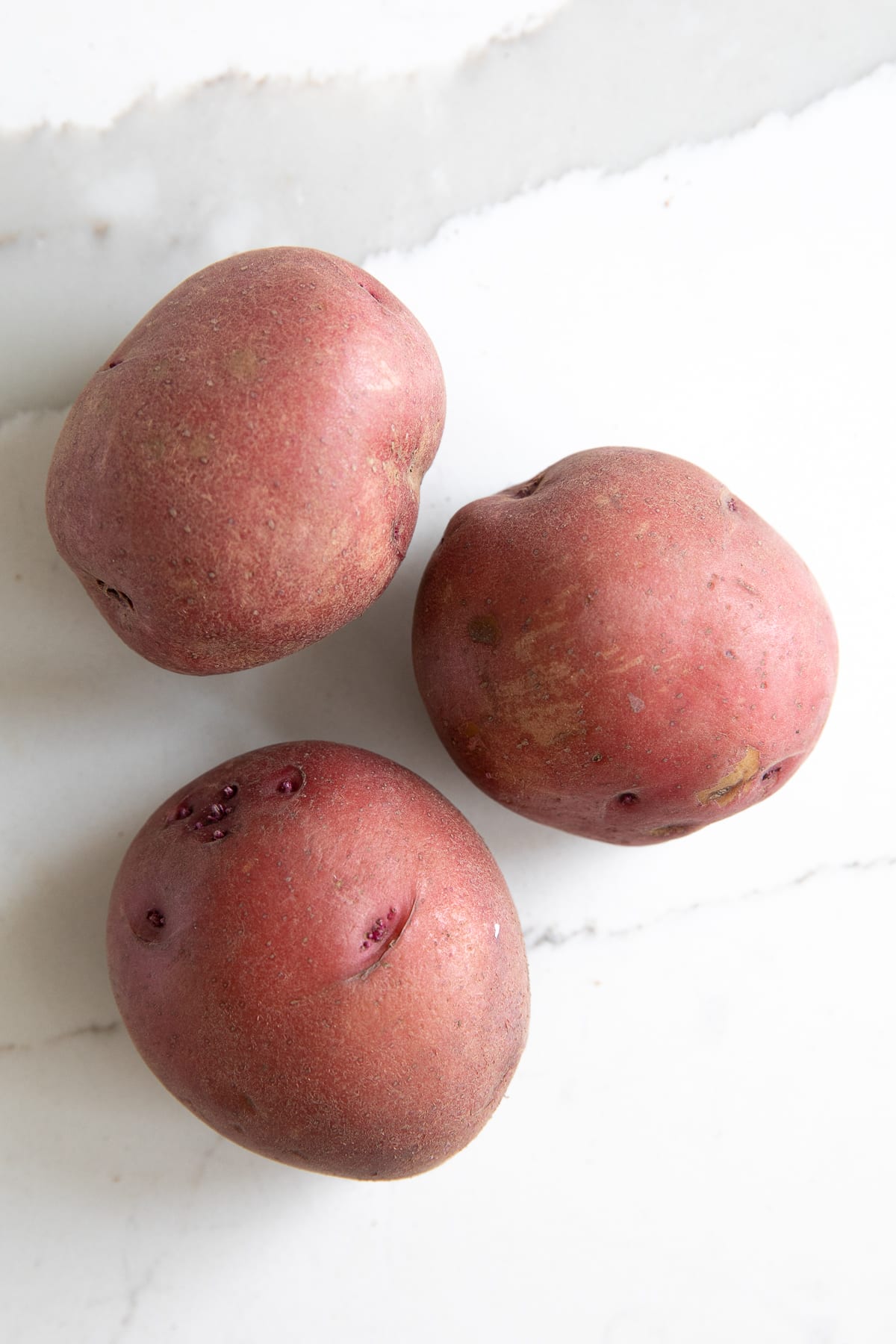
The thin skin remains intact, and the white, creamy flesh remains firm, no matter the preparation. The ideal option for making potato salad, clambakes, stews, soups, or even summertime grilling.
Varieties include Red Bliss, Norland, and Red Pontiac.
Yellow (Waxy)

Usually round to oblong in shape with thin yellowish to light brown skins. They have a creamy, buttery, yellow-colored flesh and are best suited for boiling, steaming, mashing, roasting, grilling, and au gratin dishes. These also work well to add structure to soups and stews.
Varieties include Yukon gold, yellow Finn, German Butterball, Carola, Nicola, and Alby’s Gold.
White (All-Purpose)
There are two main types of white potatoes: round white and long white potatoes. Both types have light tan skin and white flesh with a medium level of starch. They are extremely versatile, although they are often considered the best for fries as they hold up well under high heat and have a unique nutty flavor. Also great for potato salad and soups.
Purple/Blue (All-Purpose)
More of an earthy flavor, so may not be the best beginner potato. If you’re looking to keep its pretty purple/blue color even after cooking, the best way to do so is by cooking it in the microwave.
Popular varieties include Purple Majesty, Purple Peruvian (fingerling variety), All Blue, and Purple Viking.
Russet (Starchy)
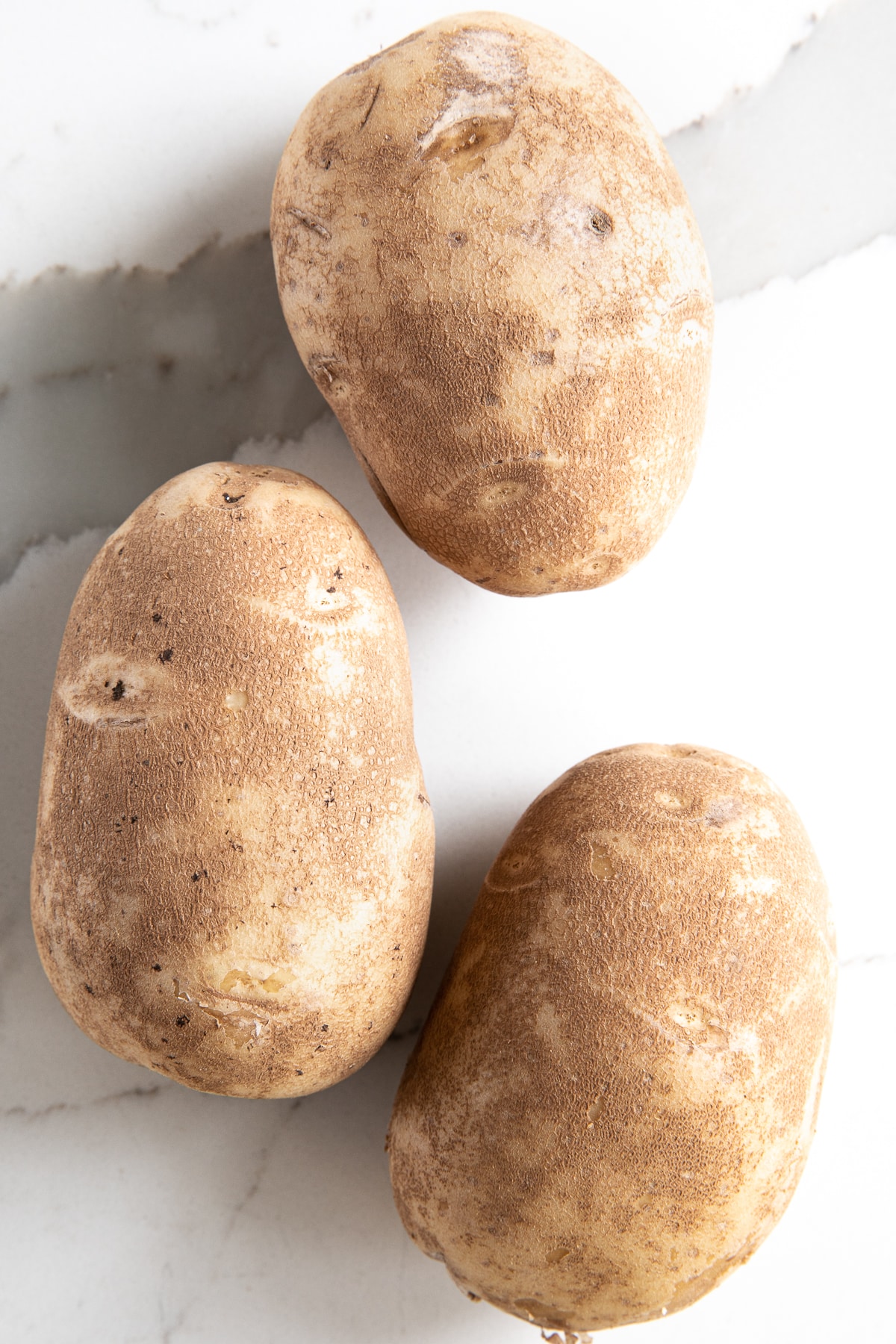
The picture-perfect baked potato, its interior becomes super fluffy, and the skin adds great texture and nutrition. It can also be mashed or fried effectively.
Fingerling (Waxy)
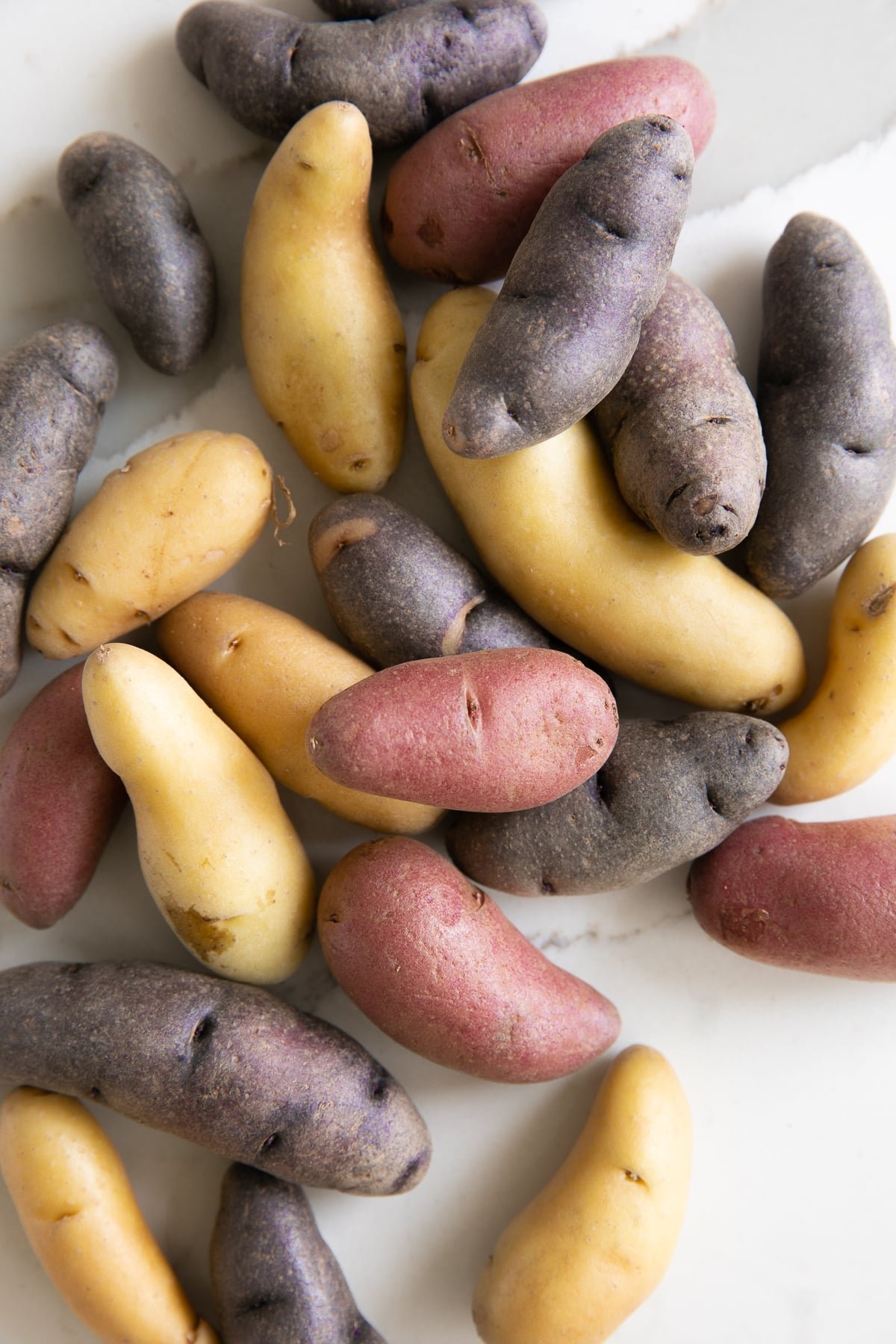
Distinctly shaped with a buttery flavor, these are a fan favorite that can instantly elevate a formal dinner. Awesome when baked, boiled, steamed, fried, and roasted.
Varieties include Ruby crescent fingerlings, Russian banana fingerlings, long white fingerlings, and purple Peruvian fingerlings.
Petite (Varies)
Petite potatoes are simply bite-sized versions of larger potato varieties. More flavor-packed, they are cooked and served whole. We love grabbing a big bag filled with crazy colors and cooking them all together.
What About Sweet Potatoes?
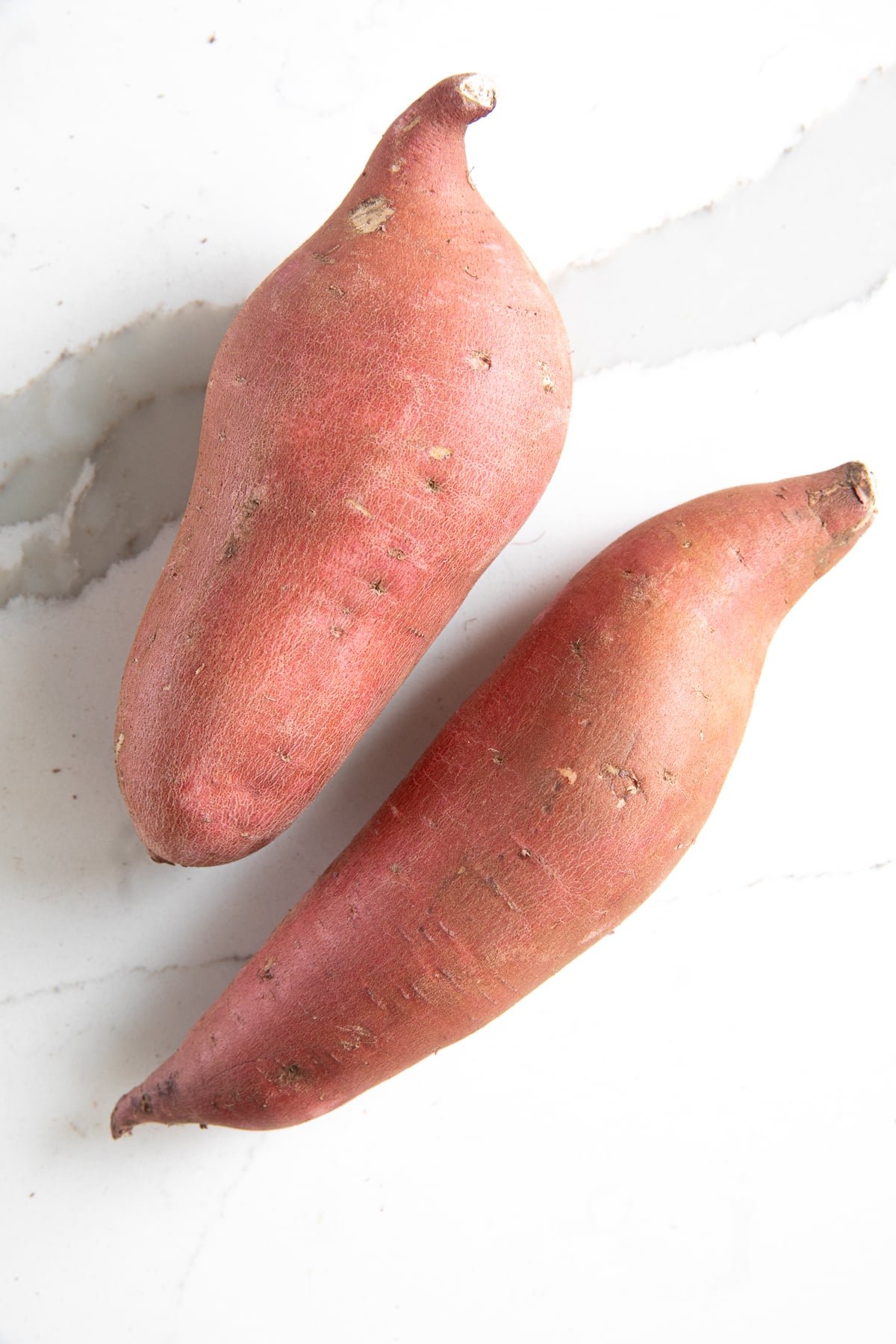
Sweet potatoes and white potatoes come from entirely different plant families.
Although they are each considered root vegetables, sweet potatoes are actually from the morning glory family, whereas regular white potatoes are part of the nightshade family. They differ from other potatoes in appearance, taste (they’re significantly sweeter!), and nutritional value.
There are many different types of sweet potatoes (and yams- although yams are, yes, an entirely different species, too) that can be found in all different types of shapes, sizes, and colors, from red to yellow and even purple.
Much like regular potatoes, sweet potatoes are delicious baked, boiled, steamed, fried, roasted, pureed, or mashed. A few of my favorite sweet potato recipes include,
Waxy vs. Starchy
One distinction you’ll hear from potato lovers is starchy vs. waxy. The other catch-all category is all-purpose, which is a smart place to start. It may seem like a weird way to describe food, but you should know which potatoes belong to each category to make the best choice for your meals.
The key factor that separates the two types of potatoes is the moisture level, which determines how they cook.
Starchy potatoes generally contain low moisture and, you guessed it–more starch. Think about the fluffy, flaky flesh of a baked Russet potato or the way that Red potatoes mash together perfectly but do not become congealed or gluey.
Starchy potatoes are also great for French fries because they keep a somewhat stiff structure while remaining soft on the inside. The ultimate fries have a crispy exterior and are still a bit mushy in the middle.
On the other hand, waxy potatoes, such as Fingerlings, Creamers, and Baby Potatoes, contain higher levels of moisture and have thinner skin, allowing them to retain their shape better during cooking. This gives you the best potato salads, gratins, and casseroles.
We also think that you should stick with waxy potatoes when adding to your favorite soup since the individual pieces will not fall apart in the heat or end up lost in the broth.
Selecting and Storing
Selecting potatoes is pretty straight-forward, however, keep these simple tips in mind the next time you reach for a 5-pound bag of russets.
- Feel for potatoes that are heavy for their size and firm
- Avoid potatoes with wrinkly skin, soft spots, cracks, or overly dirty skin
- Finally, avoid potatoes that come with a green tinge. This means that they have been overexposed to light, causing them to release the toxin, solanine. Consume too much of this toxin, and it could make you sick
When storing your potatoes, try to find a cool, dark place, out of direct sunlight, ideally, between 50-65 degrees Fahrenheit. It is also important to remember that you should never refrigerate potatoes or store them directly near onions.
When stored properly, waxy potatoes will keep for 2-3 weeks, while starchy and all-purpose potatoes will last for up to two months!
Best Ways to Prepare Potatoes for Cooking
Depending on the size, structure, and starchiness of a potato, you’ll want to take a specific approach when it comes to cooking.
Just remember that no matter which type of potato you choose, you’ll need to cook them through 100% of the way! These are nightshades, and need to be thoroughly cooked for the safety of you and your family–never eat potatoes raw!
We’ve mapped out the most popular ways to prepare potatoes and included some constraints and caveats to help you avoid common pitfalls.
- ROASTING: Chop up your preferred potatoes, drizzle them with oil, and throw them on a tray to be blasted with high (dry) heat! This will yield that signature crispy skin and unleash the earthy, nutty flavors of the starch.
- BAKING: Make sure to puncture holes in the potato before baking. Once it’s steaming hot and cooked through, load it up with whatever decadent toppings you desire. Butter, sour cream, bacon bits, and cheese. Nothing is off-limits!
- MASHING: Whether you bake or boil your potatoes, they taste amazing when mashed up with a fork or a specific mashing tool. Just don’t pulverize those tubers too hard, because the starch can become congealed and unappetizing.
- FRYING: Slice the potato up into tiny slivers or carve big, bold steak fries. Steam or boil them before frying in peanut or vegetable oil for that perfect soft center. Sprinkle a little bit of salt, squirt some ketchup, and you have an all-time great snack or side dish.
- SAUTEING: One-pan stove-top potatoes can be done in 15 minutes by first steaming and then tossing some waxy tubers in oil. It’s a fast and easy way to serve up some big flavor or piece together a quick potato salad on the fly.
- GRILLING: Yes, you can grill potatoes, and they taste amazing! Just wrap them up in a single layer of tin foil and throw them on the flame with the rest of the meat and vegetables. Just keep turning them over to get an even cook.
- MICROWAVING: We’re never thrilled to use the microwave, but it works for making a decent baked potato in around five minutes. Just leave the tin foil behind and opt for a glass bowl to keep it in place.
- PUREES: Bring your potatoes to a new level of decadence by adding cream, seasoning, and blasting it all with an immersion blender. This classic “Vichyssoise” is one of the best things you’ll ever try!
That pretty much covers the basics of potato preparation, and any recipes you come across will build on those fundamentals, so study up!
Our Favorite Potato Recipes
You won’t be shocked that we recommend starting with our Perfect Baked Potato recipe. Once you master this recipe, it will stay in your arsenal forever.
From there, try some cheesy Twice-Baked Potatoes, basic Garlic-Roasted Potatoes, or my favorite Mashed Potatoes recipe. These aren’t necessarily difficult, but they require just a bit more technique and focus.
After that, you can graduate to some gourmet creations like Creamy Scalloped Potatoes or Cheesy Potatoes Au Gratin. Not our healthiest recipes, we admit, but two of the best possible side dishes for a special occasion or holiday with the family.
Finally, try out a Herb Roasted Sweet Potato Recipe that brings some savory sweetness to the table. Although it may not be in the same family as the other potatoes we discussed, it’s an honorable mention that everyone in the house will enjoy.
Just keep experimenting with new varieties and recipes, and you’ll soon be able to do it all!
Conclusion
In our eyes, there’s no such thing as a bad potato recipe. Even the most minimal-effort roasted potato dish is a comforting and satisfying addition to any meal.
We love that you can always find new ways to use leftover potatoes as well, whether it’s making a tasty deli salad or reviving them in a casserole the next night.
If you haven’t yet mastered this crucial ingredient, we suggest you get to work and pick up a bunch of different types when you hit the next farmers’ market.
Until then, be sure to sign up for our email newsletter so you never miss a potato recipe update!
